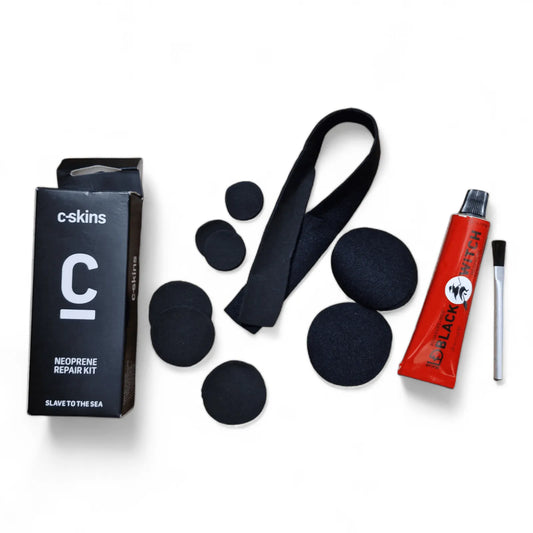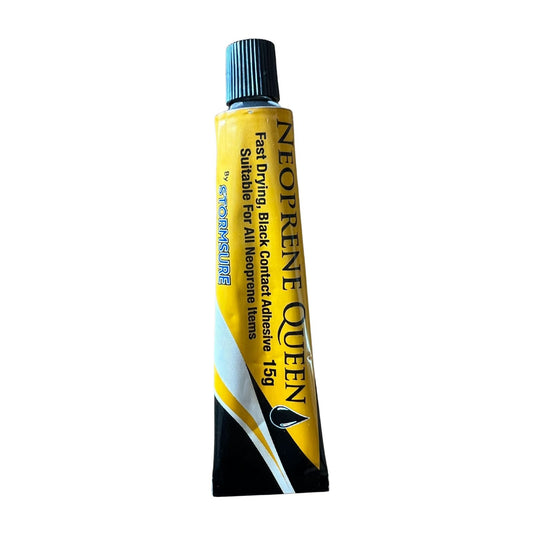Collection: Wetsuit Repair
DIY Wetsuit Repair Kits
Keep your wetsuit in top condition with our DIY wetsuit repair kits. Perfect for surfers, divers, and water sports enthusiasts, these kits make repairing rips and tears simple.
DIY Wetsuit Repair Kits
Keep your wetsuit in top condition with our DIY wetsuit repair kits. Perfect for surfers, divers, and water sports enthusiasts, these kits make repairing rips and tears simple.
View our full wetsuit range here
Our kits are designed for all types of wetsuits, including full suits, spring suits, and shorties. With easy-to-follow instructions, anyone can fix small rips or damaged seams at home. They are compact and travel-friendly, making them ideal for repairs at home or on the road.
Each kit includes high-quality neoprene glue repair materials and wetsuit patches. You can restore flexibility, waterproofing, and insulation without professional help. The adhesive sets quickly, so you can resume your activities in minimal time.
Small tears or holes are common in surf or dive wetsuits. Our kits allow wetsuit patching that lasts and keeps your suit performing well. Avoid the hassle and expense of professional wetsuit repair. They are designed to create smooth, flexible patches that don’t affect comfort or movement.
If your seams are coming apart, you can perform wetsuit seam repairs at home. The kit’s adhesive is designed to bond neoprene securely, creating a durable, waterproof fix. Even curved or awkward seam areas can be repaired easily with the included tools.
For damaged zippers or worn-out areas, our kits provide solutions for minor repairs. This includes simple fixes for wetsuit zippers repair, ensuring your suit stays functional. The kits are versatile enough to handle multiple repairs on the same suit.
Using our kits is safer and more reliable than makeshift repairs. With proper DIY wetsuit repair, you prevent small problems from turning into big issues. They allow you to take control of your wetsuit’s care, saving time and frustration.
We also provide wetsuit maintenance tips to help your suit last longer. Rinse after use, dry properly, and store correctly. Regular care reduces future damage. Our guide helps you identify weak points early, so repairs are easier and more effective.
Our affordable repair kits save you money. Rather than replacing your suit, you can restore it quickly at home. It’s convenient, cost-effective, and sustainable. Repairing your wetsuit extends its lifespan and reduces environmental waste.
Even older wetsuits can benefit. Our wetsuit restoration materials make your suit feel almost new again. Flexible, waterproof patches and adhesives keep your suit ready for every session. Your suit regains strength, flexibility, and thermal performance after every repair.
Our kits are perfect for both beginners and experienced users. Clear instructions guide you through the repair process step by step. No prior experience is needed. Each kit is designed for confidence and ease, ensuring successful repairs every time.
Whether you surf, dive, or paddleboard, our professional-grade DIY repair kits are designed for durability. They withstand repeated use and daily water exposure. The materials are marine-grade, ensuring long-lasting waterproof performance.
We include tips on preventing damage in the future. Simple habits, like avoiding hot surfaces and handling your wetsuit carefully, extend its life. Regular inspections combined with DIY repairs prevent costly replacements.
With our kits, you don’t need to wait for a professional service. Perform repairs at your convenience and get back in the water faster. Perfect for last-minute fixes before trips or surf sessions.
From minor tears to seam issues, our kits cover common wetsuit problems. Using high-quality adhesives ensures your neoprene repair is strong and flexible. They maintain the suit’s original stretch and comfort, so movement is never restricted.
Our goal is to help you enjoy your water sports without interruption. DIY repairs with our kits are easy, safe, and effective. Keep your wetsuit performing like new. With our kits, you gain independence, confidence, and peace of mind while protecting your investment.
Need More Help Or Advice?
If you’re looking for expert advice, tips, or guidance on anything surf or skate related, we’re here to help! At Bob Gnarly Surf, we love sharing our passion and knowledge to make sure you get the most out of your time on the waves or the board. Whether it’s choosing the right gear, learning new techniques, or simply getting some pro recommendations, don’t hesitate to reach out. The easiest way to get in touch is through our live chat—just click the blue button at the bottom of your screen. Our team is ready to answer your questions.
Read Less-
C-Skins Wetsuit and Neoprene Repair Kit
Vendor:C-SkinsRegular price £9.99 GBPRegular price -
Ocean & Earth Ultimate Wetsuit Repair Kit
Vendor:Ocean & EarthRegular price £14.99 GBPRegular price -
Stormsure - Neoprene Queen Wetsuit Repair Kit - Black
Vendor:Circle One SurfRegular price £7.20 GBPRegular price -
Stormsure - Neoprene Queen Wetsuit Repair 15g - Black
Vendor:Circle One SurfRegular price £5.99 GBPRegular price

WIN SURF GEAR
Enter our epic prize draw competitions for as little as 99p a ticket








